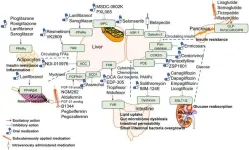(Press-News.org)
Young adults who vape show chemical changes in their DNA similar to those found in young adults who smoke — changes known to be linked to the development of cancer — according to a new study just published in the American Journal of Respiratory Cell and Molecular Biology.
A team of researchers from the Keck School of Medicine of USC measured DNA methylation, a chemical modification of DNA that can effectively turn genes “on” or “off, in the oral cells of young adult vapers, smokers and non-users. DNA methylation is vital to normal cellular processes but if it goes awry it can lead to cancer and other diseases. Using a state-of-the-art genetic sequencing technique, they analyzed virtually the entire genome in the cells of study participants, compared to previous studies that analyzed just two to three percent of genetic regions in vapers or smokers.
The researchers found substantial overlap in DNA methylation patterns, a type of epigenetic modification, between people who vaped versus those who smoked.
“Our findings indicate that the changes in DNA methylation observed in vapers may contribute to the development of disease, including cancer,” said Stella Tommasi, PhD, an associate professor of research population and public health sciences at the Keck School of Medicine and the study’s lead author.
“Electronic cigarettes are not as safe as some people claim that they are, even if the level of most toxicants and carcinogens present in e-liquid and vapor is generally much lower than that found in cigarette smoke,” she said.
The study, supported in part by the National Institutes of Health, contributes to a growing evidence base on the health risks of vaping. It also provides a basis for future research that seeks to identify a molecular signature to assess the disease risks associated with vaping.
In the meantime, the research team hopes the study can further emphasize the potential harms of vaping as new products continue to hit the market.
“These findings have significant implications for public health and tobacco regulation that aim to keep vaping products away from young people, who are a particularly vulnerable population,” Tommasi said.
Comparing DNA methylation
The study included 30 young adults, average age 23.5 years, divided into three groups: vapers (people who vaped at least three times a week for at least 6 months, but did not smoke), smokers (people who smoked at least three times a week for at least one year, but did not vape) and non-users (people who neither vaped nor smoked).
Researchers matched the groups by age, race and gender. They also accounted for potential confounding factors, including how much alcohol or grilled food each participant consumed.
After collecting oral cell samples from the cheeks of each participant, the researchers used a high-resolution sequencing technique, known as whole genome bisulfite sequencing, to study more than 25 million sites across the genome. They searched for differentially methylated regions (DMRs), or areas in the genome that were more or less methylated in one group of participants compared to the others. They found 831 DMRs in vapers and 2,863 in smokers.
Next, the researchers looked for DMRs that were shared between smokers and vapers, finding 346 (46% of all DMR-associated genes in vapers) that overlapped between the two groups. These methylated regions were on gene sites known to regulate important biological signaling pathways that drive disease development. This indicates that DNA methylation in vapers, much like in smokers, can contribute to the development of diseases such as cancer, Tommasi said.
A key finding from the study was that the most significant DMR most shared between vapers and smokers was located within HIC1, a tumor-suppressor gene named Hypermethylated In Cancer 1 because of the extensive research base linking it with various cancers, including those linked to tobacco use.
HIC1 is altered by methylation at a very early stage in cancer development. Methylation of HIC1 has also been found in blood samples of smokers who are at high risk of cancer and other chronic diseases. This means it may be useful as a predictive biomarker to help identify people who need to be monitored closely so cancer can be diagnosed early on when it is easiest to treat.
“This is an exciting discovery because the methylation of this gene has never before been identified in vapers,” Tommasi said.
Of significance, more than half of the DMRs found in vapers were not detected in smokers. That finding is consistent with the fact that e-cigarettes produce a wide range of harmful or potentially harmful chemicals, some of which are not found in tobacco cigarettes, the researchers said.
Drilling down on the impact of vaping
The research team is now examining a separate, larger group of participants to learn more about the impact of vaping on DNA methylation. They want to know whether the types of flavors and additives in e-cigarettes, as well as the duration and intensity of vaping, impact DNA methylation. Their goal is to establish a molecular signature for vaping that can be used to assess the risks associated with vaping in the general population.
“This study presents a lot of opportunities,” she said. “It shows us that there are a multitude of candidate genes that can explored for assessing the risk of disease in vapers.”
About this research
In addition to Tommasi, the study’s other authors are Ahmad Besaratinia from the Department of Population and Public Health Sciences and the Norris Comprehensive Cancer Center, Keck School of Medicine of USC, University of Southern California; and Luciano Brocchieri and Silvia Tornaletti from TB-Seq Inc., South San Francisco, California.
This work was supported by the National Institute of Dental and Craniofacial Research, the National Cancer Institute and National Institute on Drug Abuse of the National Institutes of Health [R01DE031863, R21CA268197 and R21DA058342] and the University of California Tobacco-Related Disease Research Program [T31IR1839, T32IR5144 and T33IR6680].
END
DALLAS, Sept. 25, 2024 — The American Heart Association, celebrating 100 years of lifesaving service as the world’s leading nonprofit organization focused on heart and brain health for all, is joining with other top cardiovascular research funders around the world to support an international scientific research grant focused on women’s cardiovascular health. Scientific researchers around the world are invited to apply for the award to foster global advancements in understanding and improving the diagnosis, treatment and prevention of cardiovascular disease (CVD) among women.
A 2022 presidential advisory ...
Non-alcoholic fatty liver disease (NAFLD), recently reclassified as metabolic dysfunction-associated steatotic liver disease (MASLD), has become the most prevalent chronic liver disease globally. This reclassification underscores the metabolic dysfunction central to the disease, which spans a spectrum from simple steatosis to more severe forms like steatohepatitis, fibrosis, and cirrhosis. Given the significant overlap between MASLD and type 2 diabetes mellitus (T2DM), the therapeutic strategies for MASLD have increasingly focused on addressing metabolic derangements. Despite its global prevalence, no specific drugs have been approved for MASLD, highlighting an urgent need ...
September 25, 2024 (Washington, DC)—The Kissick Family Foundation Frontotemporal Dementia (FTD) Grant Program, in partnership with the Milken Institute Science Philanthropy Accelerator for Research and Collaboration (SPARC), today announced six research teams awarded two-year grants to advance scientific understanding of FTD, totaling $3 million in new funding for this disease.
This inaugural cycle of the Kissick Family Foundation FTD Grant Program represents a unique philanthropic strategy that specifically targets basic or early-stage translational research projects that focus on those disease cases ...
Metastatic cancer can be a devastating diagnosis. The cancer is spreading. It may travel to multiple organs in the body. This could mean more pain and ultimately, death.
Unfortunately, just how cancer spreads remains unclear. But now, Cold Spring Harbor Laboratory (CSHL) Professor Adam Siepel and colleagues have a way to better understand that process. New technology developed at Weill Cornell Medicine barcodes cells to track the highways by which prostate cancer spreads throughout the body.
The resulting roadmap shows that most cancer cells actually stay put within the tumor. However, ...
Augmented reality (AR) takes digital images and superimposes them onto real-world views. But AR is more than a new way to play video games; it could transform surgery and self-driving cars. To make the technology easier to integrate into common personal devices, researchers report in ACS Photonics how to combine two optical technologies into a single, high-resolution AR display. In an eyeglasses prototype, the researchers enhanced image quality with a computer algorithm that removed distortions.
AR systems, like those in bulky goggles and automobile head-up displays, require portable optical components. But shrinking the typical four-lens AR system to the size of eyeglasses or smaller ...
Professor Ron Boschma is the first Dutch person to receive the Prix Vautrin Lud, the highest academic award within the field of geography. The award will be presented in Saint-Dié-des-Vosges, France on 6 October. Prior to the award ceremony, Prof. Boschma will give an invited lecture at the Sorbonne University in Paris on 4 October. Boschma was nominated for the award in recognition of his scientific contributions to the field of economic geography, especially for laying the foundations of evolutionary economic geography and his research into regional diversification and innovation policy. The European Union’s regional policy is based in part on his ...
Research Highlights Risk to Both Humans and Wildlife, Suggests Need for New Collision Mitigation Strategies
A recent article published in PeerJ Life & Environment has uncovered insights into how mallards (Anas platyrhynchos) respond to approaching vehicles, revealing that these common waterbirds are poorly equipped to avoid collisions, particularly at high speeds. The research, which used both simulated and real-world vehicle approaches, highlights the urgent need for improved methods to reduce bird-vehicle collisions—events that are not only financially costly but also dangerous to both humans and wildlife.
The study focused ...
About The Study: In this randomized clinical trial, home-based phototherapy was as effective as office-based phototherapy for plaque or guttate psoriasis in everyday clinical practice and had less burden to patients.
Corresponding Author: To contact the corresponding author, Joel M. Gelfand, MD, email joel.gelfand@pennmedicine.upenn.edu.
To access the embargoed study: Visit our For The Media website at this link https://media.jamanetwork.com/
(doi:10.1001/jamadermatol.2024.3897)
Editor’s Note: Please see the article for additional information, including other authors, ...
Large expansion of carbon capture and storage is necessary to fulfill the Paris Climate Agreement. Yet a new study led by Chalmers University of Technology, in Sweden and University of Bergen, in Norway, shows that without major efforts, the technology will not expand fast enough to meet the 2°C target and even with major efforts it is unlikely to expand fast enough for the 1.5°C target.
The idea behind carbon capture and storage (CCS) technology is to capture carbon dioxide then store it deep underground. Some applications of CCS, such ...
An “invisible forest” of phytoplankton is thriving in part of our warming ocean, new research shows.
Phytoplankton are tiny drifting organisms that do about half of the planet’s “primary production” (forming living cells by photosynthesis).
The new study, by the University of Exeter, examined phytoplankton at the ocean surface and the “subsurface” – a distinct layer of water beneath – to see how climate variability is affecting them.
Published in the journal Nature Climate Change, the findings show these two communities are reacting differently.
Over the last decade, the total “biomass” (living material) of subsurface ...





